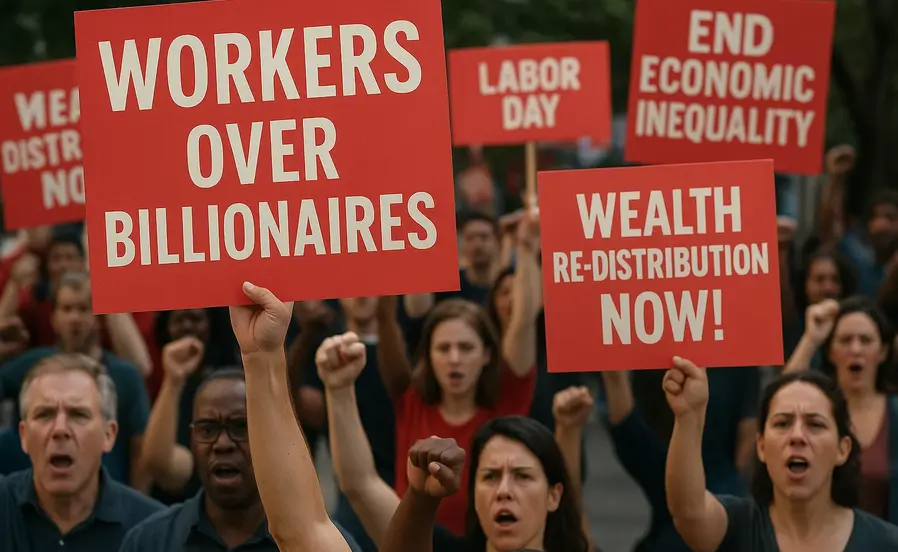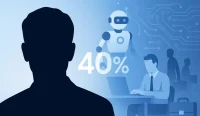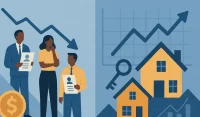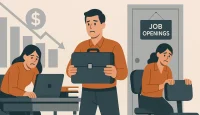The Labor Day protests economic inequality movement has reached a boiling point across America, with working-class families taking to the streets to demand fundamental changes to a system they believe has failed them. Since Trump took his second term in 2025, protests have erupted from major cities to small towns, with countless demonstrations during Labor Day weekend covering multiple priorities. The Labor Day protests economic inequality movement has become a powerful voice for economic justice, calling for fair wages, accessible healthcare, and a fundamental redistribution of wealth that puts working families before billionaires.
The Growing Movement for Economic Justice
The Labor Day protests economic inequality movement represents a fundamental shift in American labor activism, moving beyond traditional union demands to address the broader systemic issues of wealth concentration and economic injustice. Protesters are calling for a simple but revolutionary concept: workers over billionaires. This message has resonated across the country, uniting people from diverse backgrounds who share a common frustration with an economic system that seems designed to benefit the wealthy at the expense of working families.
The movement’s core demands are straightforward yet profound. Protesters want to see economic equality, fair wages, and accessible healthcare become the foundation of American economic policy. They’re calling for a system where the wealthy pay their fair share of taxes and where working families can achieve economic security without struggling to make ends meet. The Labor Day protests economic inequality movement has made it clear that the current system is unsustainable and that change is not just desirable but necessary for the survival of the American middle class.
The “Workers Over Billionaires” Philosophy
The “Workers Over Billionaires” philosophy that drives the Labor Day protests economic inequality movement is based on a simple principle: in a country that produces enormous profits, it’s important that those profits benefit the people who create them. Protesters argue that the current system has created a massive transfer of wealth from working families to the wealthiest people in the country, creating a situation where billionaires pay lower tax rates than middle-class workers.
This philosophy has gained traction because it addresses a fundamental truth about the American economy: there are way more billionaires today than there have ever been, and there’s way more poverty and homelessness than there should be. The money exists, but it’s in the wrong places. The Labor Day protests economic inequality movement is demanding that this imbalance be corrected through policies that ensure fair taxation and wealth redistribution.
The Reality of Wealth Inequality in America
The Labor Day protests economic inequality movement has brought renewed attention to the stark reality of wealth inequality in America. Protesters point out that while corporate profits and executive compensation have reached record levels, working families have seen their real wages stagnate or decline. This has created a situation where the gap between the wealthy and working Americans has become so large that it threatens the very foundation of American democracy.
The statistics are staggering. The wealthiest 1% of Americans now control more wealth than the bottom 90% combined. Meanwhile, millions of working families struggle to afford basic necessities like housing, healthcare, and education. The Labor Day protests economic inequality movement has made it clear that this situation is not the result of natural economic forces but of deliberate policy choices that favor the wealthy over working families.
The Tax System’s Role in Inequality
One of the central issues driving the Labor Day protests economic inequality movement is the perception that the tax system is fundamentally unfair. Protesters argue that billionaires and corporations are not paying their fair share, while working families bear the burden of funding essential government services. This has created a situation where the people who can least afford it are paying the highest effective tax rates.
The movement has called for a fundamental restructuring of the tax system to ensure that the wealthy pay their fair share. This includes closing tax loopholes that allow billionaires to pay lower rates than their employees, implementing wealth taxes on the super-rich, and ensuring that corporations pay their fair share of taxes. The Labor Day protests economic inequality movement has made it clear that without these changes, the current system will continue to transfer wealth from working families to the wealthy elite.
The Impact on Working Families
The Labor Day protests economic inequality movement has highlighted the devastating impact of current economic policies on working families. Many protesters are people who work full-time jobs but still struggle to make ends meet. They’re calling for policies that would ensure that work provides a pathway to economic security rather than a life of constant struggle.
The movement has particularly focused on the need for fair wages that reflect the true cost of living. Many protesters work multiple jobs just to afford basic necessities, while their employers post record profits. The Labor Day protests economic inequality movement has made it clear that this situation is unsustainable and that working families deserve better.
Healthcare and Economic Security
Access to affordable healthcare has been a central demand of the Labor Day protests economic inequality movement. Many working families are one medical emergency away from financial ruin, despite working full-time jobs. The movement has called for policies that would ensure that healthcare is accessible to all Americans, regardless of their income level.
The protesters argue that in a country as wealthy as America, no one should have to choose between paying for healthcare and paying for food or rent. The Labor Day protests economic inequality movement has made it clear that access to healthcare is not a luxury but a fundamental right that should be guaranteed to all Americans.
The Response from Critics
The Labor Day protests economic inequality movement has faced criticism from those who argue that the protesters are misguided or that their demands are unrealistic. Some critics have suggested that the protesters don’t understand economics or that their demands would harm the economy. However, the movement has responded by pointing out that the current system is already harming the economy by creating unsustainable levels of inequality.
The protesters have also faced criticism for their confrontational approach and their willingness to challenge the status quo. However, the Labor Day protests economic inequality movement has made it clear that they are not willing to accept the current system and that they will continue to fight for change until their demands are met.
The Media’s Role in the Movement
The Labor Day protests economic inequality movement has received significant media attention, both positive and negative. Some media outlets have focused on the confrontational aspects of the protests, while others have highlighted the legitimate concerns of working families. The movement has worked to ensure that their message is heard and that the public understands the real issues driving the protests.
The protesters have also used social media and other platforms to spread their message and organize additional demonstrations. The Labor Day protests economic inequality movement has shown that in the digital age, grassroots movements can have a significant impact on public discourse and policy debates.
Workers Over Billionaires
The Labor Day protests highlight growing frustrations with inequality and calls for fairer wealth distribution. Employers can take the lead by offering real opportunities that value workers and drive economic progress. Post your job on WhatJobs today and connect with candidates eager to build a fairer, more sustainable future.
Post a Job Free for 30 Days →The Future of the Movement
The Labor Day protests economic inequality movement shows no signs of slowing down. The protesters have made it clear that they will continue to fight for economic justice until their demands are met. The movement has already had a significant impact on public discourse and has forced politicians and policymakers to address issues of wealth inequality and economic justice.
The movement has also inspired similar protests in other countries, showing that the issues of wealth inequality and economic injustice are not unique to America. The Labor Day protests economic inequality movement has become part of a global movement for economic justice that is challenging the fundamental assumptions of neoliberal economic policy.
Building Coalitions for Change
The Labor Day protests economic inequality movement has worked to build coalitions with other groups that share similar concerns about economic justice. This includes labor unions, community organizations, and advocacy groups that are fighting for similar causes. The movement has shown that by working together, these groups can have a greater impact than they could have individually.
The protesters have also reached out to elected officials and policymakers to discuss their concerns and to push for policy changes. The Labor Day protests economic inequality movement has made it clear that they are not just protesting but are actively working to create change through the political process.
The Economic Impact of the Protests
The Labor Day protests economic inequality movement has had a significant economic impact, both directly and indirectly. The protests have disrupted business operations in some areas and have drawn attention to the economic issues facing working families. The movement has also inspired consumer boycotts and other forms of economic activism that have put pressure on corporations and policymakers.
The protesters have also highlighted the economic costs of inequality, showing how the concentration of wealth in the hands of a few has negative consequences for the broader economy. The Labor Day protests economic inequality movement has made it clear that addressing wealth inequality is not just a matter of fairness but is also essential for economic growth and stability.
The Role of Technology in Organizing
The Labor Day protests economic inequality movement has used technology effectively to organize and coordinate their activities. Social media platforms have been used to spread information about protests, to coordinate logistics, and to share stories about the impact of economic inequality on working families. The movement has shown that technology can be a powerful tool for grassroots organizing and social change.
The protesters have also used technology to document their activities and to share their message with a broader audience. The Labor Day protests economic inequality movement has shown that in the digital age, grassroots movements can reach people around the world and can have a significant impact on public discourse.
Conclusion
The Labor Day protests economic inequality movement represents a fundamental challenge to the current economic system and a demand for a more just and equitable society. The protesters have made it clear that they will not accept a system that favors billionaires over working families and that they will continue to fight for economic justice until their demands are met.
The movement has already had a significant impact on public discourse and has forced policymakers to address issues of wealth inequality and economic justice. The Labor Day protests economic inequality movement has shown that when working families come together to demand change, they can have a powerful impact on society and can force the political and economic establishment to listen to their concerns.
Frequently Asked Questions
What sparked the Labor Day protests economic inequality movement?
The Labor Day protests economic inequality movement was sparked by growing frustration among working families with a system that favors billionaires over working people, including unfair tax policies, stagnant wages, and lack of access to affordable healthcare.
What are the main demands of the Labor Day protests economic inequality movement?
The main demands include fair wages that reflect the cost of living, accessible healthcare for all Americans, fair taxation that requires billionaires to pay their fair share, and policies that put workers over billionaires in economic decision-making.
How widespread are the Labor Day protests economic inequality demonstrations?
The protests have occurred in major cities and small towns across America, with countless demonstrations during Labor Day weekend covering multiple priorities and drawing participants from diverse backgrounds and communities.
What impact have the Labor Day protests economic inequality movement had on public discourse?
The movement has forced politicians and policymakers to address wealth inequality issues, inspired similar protests globally, and shifted public discourse toward economic justice and the need for wealth redistribution policies.
How is the Labor Day protests economic inequality movement using technology to organize?
The movement uses social media platforms to coordinate protests, share information, document activities, and reach a broader audience, demonstrating how technology can be a powerful tool for grassroots organizing and social change.
Case In Point
Consider Sarah, a single mother of two who works two full-time jobs as a retail manager and a restaurant server. Despite working 70 hours per week, she struggles to afford rent, groceries, and healthcare for her children. When she heard about the Labor Day protests economic inequality movement, she felt like someone finally understood her struggle. Sarah joined the protests in her city, carrying a sign that read “I work 70 hours per week and still can’t afford healthcare.” She stood alongside thousands of other working families who shared similar stories of economic hardship despite working multiple jobs. Sarah’s story illustrates how the Labor Day protests economic inequality movement represents real people facing real economic challenges and demanding that the system work for working families, not just billionaires. Her participation in the movement has given her hope that change is possible and that working families can have a voice in shaping economic policy.




